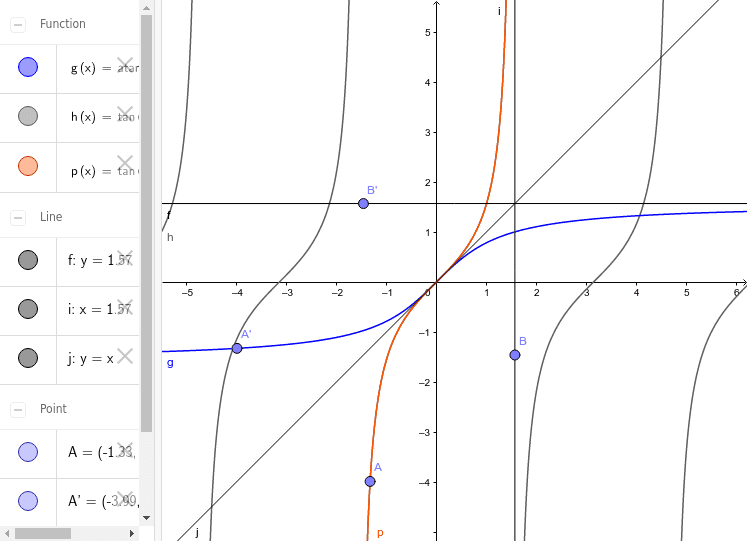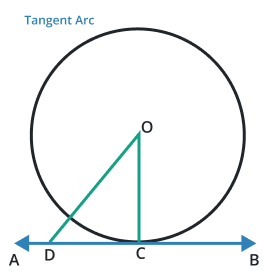En mathématiques, l’arc tangente d'un nombre réel est la valeur d'un angle orienté dont la tangente vaut ce nombre.
La fonction qui à tout nombre réel associe la valeur de son arc tangente en radians est la réciproque de la restriction de la fonction trigonométrique tangente à l'intervalle . La notation est arctan ou Arctan (on trouve aussi Atan, arctg en notation française ; atan ou tan−1, en notation anglo-saxonne (Attention de bien écrire : et non ).
Pour tout réel x :
Dans un repère cartésien orthonormé du plan, la courbe représentative de la fonction arc tangente est obtenue à partir de la courbe représentative de la restriction de la fonction tangente à l'intervalle par une réflexion d'axe la droite d'équation y = x (puisqu'elle en est la fonction réciproque).
Parité
La fonction arctan est impaire, c'est-à-dire que (pour tout réel x) .
Dérivée
Comme dérivée d'une fonction réciproque, arctan est dérivable et vérifie : .
Développement en série de Taylor
Le développement en série de Taylor de la fonction arc tangente est :
- .
Cette série entière converge vers arctan quand |x| ≤ 1 et x ≠ ±i. La fonction arc tangente est cependant définie sur tout ℝ (et même — cf. § « Fonction réciproque » — sur un domaine du plan complexe contenant à la fois ℝ et le disque unité fermé privé des deux points ±i).
Voir aussi Fonction hypergéométrique#Cas particuliers.
La fonction arctan peut être utilisée pour calculer des approximations de π ; la formule la plus simple, appelée formule de Leibniz, est le cas x = 1 du développement en série ci-dessus :
- .
Équation fonctionnelle
On peut déduire arctan(1/x) de arctan x et inversement, par les équations fonctionnelles suivantes :
- ;
- .
Fonction réciproque
Par définition, la fonction arc tangente est la fonction réciproque de la restriction de la fonction tangente à l'intervalle : .
Ainsi, pour tout réel x, tan(arctan x) = x. Mais l'équation arctan(tan y) = y n'est vérifiée que pour y compris entre et .
Dans le plan complexe, la fonction tangente est bijective de ]–π/2, π/2[ iℝ dans ℂ privé des deux demi-droites ]–∞, –1]i et [1, ∞[i de l'axe imaginaire pur, d'après son lien avec la fonction tangente hyperbolique et les propriétés de cette dernière. La définition ci-dessus de arctan s'étend donc en : .
Logarithme complexe
Par construction, la fonction arctangente est reliée à la fonction argument tangente hyperbolique et s'exprime donc, comme elle, par un logarithme complexe :
- .
Intégration
Primitive
La primitive de la fonction arc tangente qui s'annule en 0 s'obtient grâce à une intégration par parties :
- .
Utilisation de la fonction arc tangente
La fonction arc tangente joue un rôle important dans l'intégration des expressions de la forme
Si le discriminant D = b2 – 4ac est positif ou nul, l'intégration est possible en revenant à une fraction partielle. Si le discriminant est strictement négatif, on peut faire la substitution par
qui donne pour l'expression à intégrer
L'intégrale est alors
- .
Formule remarquable
Si xy ≠ 1, alors :
où
Autres utilisations
La forme en S de cette fonction fait qu'elle fait partie des fonctions dites sigmoïdes[citation nécessaire]. Par rapport à la fonction logistique de Verhulst et la fonction erf, elle est celle qui est la plus lisse, c'est-à-dire celle qui est la plus longue à rejoindre ses asymptotes.
Notes et références
Voir aussi
Articles connexes
- Atan2
- Fonction circulaire réciproque
- L'arc tangente de tout rationnel non nul est irrationnel.
- Définition de la fonction arc tangente sur les complexes
Lien externe
(en) Eric W. Weisstein, « Inverse Tangent », sur MathWorld
- Portail de la géométrie
- Portail de l'analyse




